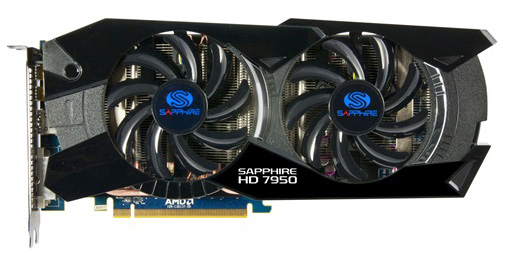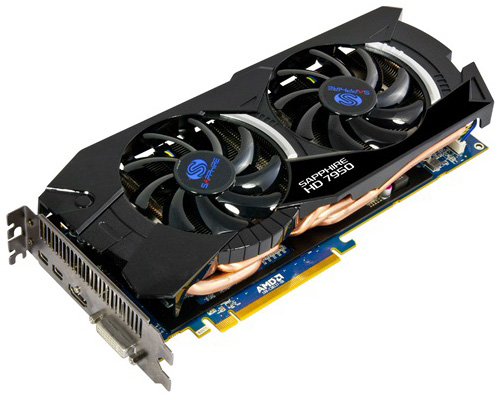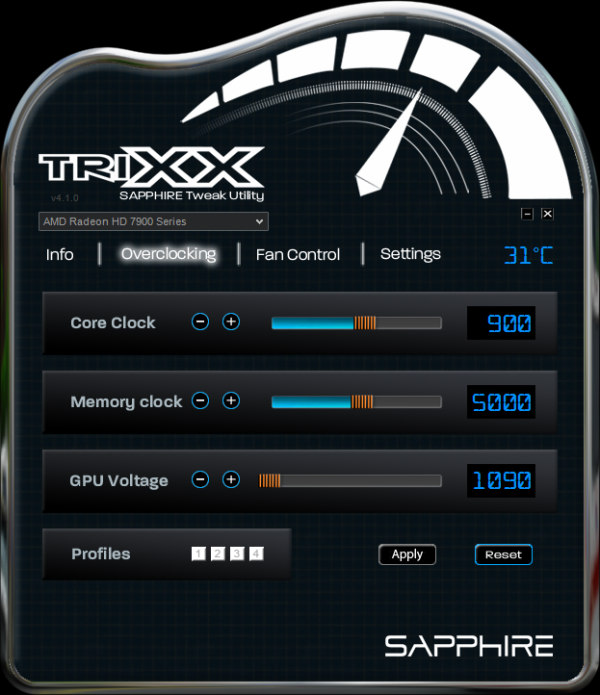AMD Radeon HD 7950 Review Feat. Sapphire & XFX: Sewing Up The High-End Market
by Ryan Smith on January 31, 2012 9:02 AM ESTMeet the Sapphire HD 7950 Overclock Edition
Since our reference 7950s are built on the 7970 PCB and cooler, we’re going to jump right into our vendor cards starting with the Sapphire HD 7950 Overclock Edition.
As with all of the 7950 cards launching today, Sapphire’s HD 7950 Overclock Edition uses the AMD 7950 PCB. This is a slightly shorter PCB measuring 10.25” long, saving .25” over the 7970 PCB by eliminating a few components that the lower board power of the 7950 makes unnecessary. The PCB is otherwise very similar to the 7970 PCB, utilizing 12 GDDR5 memory chips organized around the Tahiti GPU, while at the top you’ll find the 2 CrossFire connectors, a pair of 6pin PCIe power sockets, and the BIOS selection switch. The latter will be of particular interest to unlockers, as the switch should make it possible to safely attempt to unlock the 7950 into a 7970.

Moving on, as this is a semi-custom card the real differentiation is in the factory overclock and the cooler. On the performance side of things Sapphire will be shipping the 7950 Overclock Edition at 900MHz core and 5GHz memory, representing a 100MHz (12.5%) core overclock and no change on the memory clock.
Meanwhile for the cooler Sapphire is using what they’re calling the Dual-X cooler. The Dual-X is yet another double-wide dual-fan open air cooler, with 2 fans providing copious airflow over an aluminum heatsink running virtually the entire length of the card. Sapphire’s fan cutouts are just a bit bigger than most other dual-fan coolers and placed a bit higher, and as a result the Dual-X cooler is a bit taller than the PCB by about 15mm at its highest point. Meanwhile the cooler is also a fair bit longer than the PCB, putting the total card length at 11”.
Moving below the fans and the heatsink we’ll find the heatpipe assembly, which is responsible for carrying heat from the GPU to the heatsink. The Dual-X uses 5 copper heatpipes of varying radius that run from one end of the heatsink to the other. The 5 heatpipes converge at the base of the assembly, where a copper baseplate provides contact with the GPU. Meanwhile cooling for the VRM MOSFETs and RAM is provided by a black aluminum plate, which is placed over those components with heat transfer provided by the use of thermal pads. There is no connection between the plate and the heatsink, so the only heat dissipation from the plate is provided by whatever airflow from the fans reaches the plate.

At the front of the card we’ll find the display ports, which as this is an AMD PCB the card utilizes the standard AMD 7000 series port configuration of 1 DL-DVI port, 1 HDMI port, and 2 mini-DisplayPorts. Filling out the second slot is the grating for ventilation, though even with the ventilation slot the usual precautions for an open-air cooler apply: you’ll need a case with enough airflow to handle the roughly 200W of heat the card is capable of dumping inside of your case.
Rounding out the package is the usual collection of dongles and materials. Sapphire includes 2 molex-to-6pin PCIe adaptors, an HDMI to DVI dongle, a miniDP to DisplayPort dongle, a DVI to VGA dongle, and a 1.8m HDMI cable. Along with the dongles Sapphire packs a quick start guide and a driver installation CD.
The only thing you won’t find packed in the box is TriXX, Sapphire’s in-house overclocking utility. TriXX has been around since the 6900 series, but as this is the first high-end Sapphire card we’ve reviewed since it was released, this is the first time we’ve had it available for a review.
Fundamentally TriXX is a fairly well designed, albeit barebones overclocking utility. Along with an info readout similar to GPU-Z, TriXX provides overclocking and fan control support for Sapphire’s cards, including support for custom fan profiles and more importantly voltage control. With TriXX it’s possible to overvolt most of Sapphire’s performance and high-end cards, and as Sapphire uses AMD reference PCBs it also works with any other cards using AMD’s PCBs.
Beyond these features there’s little more to TriXX. It’s not an all-encompassing video card utility like MSI’s Afterburner, which means it comes up short if you need more functionality but it's exactly what you need if you just want to overclock. To that end it’s a clear step up compared to most other manufacturer’s poorly designed utilities, and from a design perspective its only real sin is the hard to read blue-on-black text. Otherwise it’s a competent overclocking utility that does exactly what it’s supposed to and provides voltage control for those who need it.
Finally, Sapphire will be selling the 7950 OE for $479, $30 over the baseline 7950 MSRP. Meanwhile the warranty on their card is their standard 2 year warranty.















259 Comments
View All Comments
chizow - Thursday, February 2, 2012 - link
No the prices haven't dropped because there's no need to when the 7950 is about the same performance for the same price.As for basic economics, again, you're wrong.
Prices do fall without competition, look at the CPU industry. AMD STILL doesn't have a CPU that competes with the CPUs Intel was putting out 3 years ago.
Yet prices continue to fall, Intel continues to produce faster CPUs.
Why? Because Intel is competing with itself and its consumers need incentive to buy a new CPU. People will not pay the same price for the same speed processor, they demand innovation, progress. They also won't pay significantly more for marginal increases.
They expect more performance at the same prices, which is the same expectation as in the GPU market. Unless you're AMD and their fans I guess.
chizow - Thursday, February 2, 2012 - link
I didn't say anything about the 7970's stock levels, because unlike the 7950, it did actually sell out the 1st day. But there is actually a reason for someone to upgrade to it.The 7950? Not so much, not at that price anyways. If anyone wanted that performance it was there 14 months ago for the same price.
But yeah if you want to compare to past launches, you never saw stock of 5850/5870, 470/480, 570/580 for more than a few minutes at Newegg. Why? Because the performance was there for the asking price.
With these Tahiti cards at the prices and performance, its just lukewarm reception.
chizow - Thursday, February 2, 2012 - link
Nice try deflecting. Please retract your stupid statement about "price always reflecting performance", thanks. RV770 was obviously a price mistake that AMD has clearly tried to correct over the last 3-4 generations since evident by their ever-increasing prices. Either way, you're wrong.Not to mention the 3870 wasn't even the same generation. But yes that card wasn't high end because of its lackluster performance and the fact it was late. It was a refresh of the 2900 and was up against the 8800GT, another refresh part. Regardless, it was still AMD's highest performance single-ASIC SKU, so if it wasn't high-end that just means AMD had nothing worthy of high-end that generation.
Same may happen this round if this is all SI has to offer on 28nm. :(
chizow - Thursday, February 2, 2012 - link
Sure it is, because in this price range, the only people who would be interested in buying it are the people looking to upgrade who have already spent this amount.Sure there's going to be a few first time buyers who may pick this card up and it makes some sense, but this card isn't going to be a worthwhile upgrade for the vast majority of buyers who already have something from the last few generations.
They expect more, simply put.
chizow - Thursday, February 2, 2012 - link
Sure they can, its called projecting or forecasting. It would be negligent of them to ignore what Nvidia has to offer, and similar for Nvidia. Given they share the same fab its obvious neither have a technology advantage, so you have to target your competitor's product using that same technology. Anything less would be irresponsible.chizow - Thursday, February 2, 2012 - link
Rarson, maybe we need to take a step back. You keep insisting I don't understand how this market works, or how pricing is supposed to work. Maybe you can explain how YOU think it works.Let's start off with the basics:
What do you think drives price in the GPU market?
What do you think dictates a particular price:performance metric?
Do you think these two variables continue to scale linearly to infinity as one or the other increases?
What do you think resets this price:performance metric, if at all?
If you can start by answering these questions, and then go back and try to reconcile historical price:performance data points going back to say, the 8800GTX that'd be great.
Thanks!
chizow - Thursday, February 2, 2012 - link
Translation: "I have really low expectations when it comes to GPUs on a new process/technology/architecture"So Sick - Friday, February 3, 2012 - link
CHizzo you talk about a pricing error from AMD but you know what was a the absolute least flattering act in history of the gpu?
When AMD released their Radeon 9700 pro the 5800 ultra from nv stumbled caused by an error making it incapable of running aa correctly...after that the ultimate chaos ever shown in history of hardware was spread by your beloved green hope crew. They had a communication crisis resulting in 3 different versions of their nv40 on different departments without knowing this from each other...in other words the cooperation with their own green colleagues died for a moment and time stood still. Ever since that shameful fact Nvidia is passing AMD..A lot of time they only clzaim they will be fatser in the future like they do now...thank you nv for the green hope in these dark times.....
chizzo take your shizzle talk and stop making a fool of urself please
So Sick - Friday, February 3, 2012 - link
http://nl.hardware.info/reviews/2528/22/amd-radeon...in the vid you see how 3d11 has these results:
7950oc P11392
580oc: P7500? at most...
Boushh - Friday, February 3, 2012 - link
I don't mean to rain on your parade.But when a new product is released, the most obviouse thing to do is to price it at the same level as the highest product from the competitor. Thus AMD should have priced the 7970 around the same amount as the 580.
By doing this you put the pressure on the competitor. You also make sure people choose your product because it is the same price as that of the competitor, but faster, beter, etc.
It's the same what happend just before the release of the Core architecture by Intel. AMD knew that the Core CPU's where much faster, and didn't have anything to compete. Instead of cutting the prices early and gain market share, they waited untill after the last posiible moment to lower their prices.
Sure, the made a dollar or 2, but at what price ?
Once you have the advantage on your competitor, you should use it anyway possible to harm your competitor.
And AMD has the advantage, but they fail to make any use of it at the moment.
Which gives the impresion they don't care about there market share, or if Nvidia would be forced to lower the prices of their products before they wanted to, or if Nvidia will be forced to release there products before they are ready.
But obviously you don't care about that..